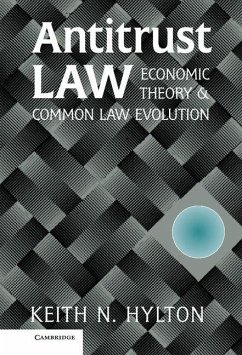Keith N Hylton
Antitrust Law
Keith N Hylton
Antitrust Law
- Gebundenes Buch
- Merkliste
- Auf die Merkliste
- Bewerten Bewerten
- Teilen
- Produkt teilen
- Produkterinnerung
- Produkterinnerung
This book is an effort to consolidate several different perspectives on antitrust law.
Andere Kunden interessierten sich auch für
![An Economic Sociology of Law Reimagined An Economic Sociology of Law Reimagined]() Clare WilliamsAn Economic Sociology of Law Reimagined167,99 €
Clare WilliamsAn Economic Sociology of Law Reimagined167,99 €![Corporate Power and Human Rights Corporate Power and Human Rights]() Corporate Power and Human Rights179,99 €
Corporate Power and Human Rights179,99 €![Turkish Accession to the EU Turkish Accession to the EU]() Eric FaucompretTurkish Accession to the EU52,99 €
Eric FaucompretTurkish Accession to the EU52,99 €![Wanted, More Than Human Intellectual Property Wanted, More Than Human Intellectual Property]() Johanna GibsonWanted, More Than Human Intellectual Property239,99 €
Johanna GibsonWanted, More Than Human Intellectual Property239,99 €![The Debates in the Several State Conventions On the Adoption of the Federal Constitution, As Recommended by the General Convention at Philadelphia in 1787 The Debates in the Several State Conventions On the Adoption of the Federal Constitution, As Recommended by the General Convention at Philadelphia in 1787]() AnonymousThe Debates in the Several State Conventions On the Adoption of the Federal Constitution, As Recommended by the General Convention at Philadelphia in 178745,99 €
AnonymousThe Debates in the Several State Conventions On the Adoption of the Federal Constitution, As Recommended by the General Convention at Philadelphia in 178745,99 €![New Frontiers of EU Funding New Frontiers of EU Funding]() New Frontiers of EU Funding137,99 €
New Frontiers of EU Funding137,99 €![American Justice in Taiwan American Justice in Taiwan]() Stephen G CraftAmerican Justice in Taiwan43,99 €
Stephen G CraftAmerican Justice in Taiwan43,99 €-
-
-
This book is an effort to consolidate several different perspectives on antitrust law.
Hinweis: Dieser Artikel kann nur an eine deutsche Lieferadresse ausgeliefert werden.
Hinweis: Dieser Artikel kann nur an eine deutsche Lieferadresse ausgeliefert werden.
Produktdetails
- Produktdetails
- Verlag: Cambridge University Press
- Seitenzahl: 430
- Erscheinungstermin: 14. April 2003
- Englisch
- Abmessung: 229mm x 147mm x 25mm
- Gewicht: 680g
- ISBN-13: 9780521790314
- ISBN-10: 052179031X
- Artikelnr.: 22733524
- Herstellerkennzeichnung
- Libri GmbH
- Europaallee 1
- 36244 Bad Hersfeld
- gpsr@libri.de
- Verlag: Cambridge University Press
- Seitenzahl: 430
- Erscheinungstermin: 14. April 2003
- Englisch
- Abmessung: 229mm x 147mm x 25mm
- Gewicht: 680g
- ISBN-13: 9780521790314
- ISBN-10: 052179031X
- Artikelnr.: 22733524
- Herstellerkennzeichnung
- Libri GmbH
- Europaallee 1
- 36244 Bad Hersfeld
- gpsr@libri.de
Keith N. Hylton has taught at the School of Law of Boston University since 1995. He previously served on the faculty and was tenured at Northwestern University School of Law. Professor Hylton currently teaches courses in antitrust, torts, and labor law, and writes widely in the field of law and economics, with more than forty publications in American law journals and peer-reviewed law and economics journals. He has served as a Director of the American Law and Economics Association.
Part I. Economics: 1. Definitions
2. Perfect competition versus monopoly
3. Further topics
Part II. Law and Policy: 4. Some interpretations issues
5. Enacting the antitrust law
6. What should antitrust law aim to do?
Part III. Enforcement: 7. Optimal enforcement theory
8. Enforcement provision of the antitrust laws
Appendix
Part IV. Cartels: 9. Cartels
10. Conscious parallelism
11. Conclusion
Part V. Development of Section 1 Doctrine: 12. The Sherman act versus the common law
13. Rule of reason and per se rule
14. Conclusion
Part VI. Rule of Reason and Per Se Rule: 14. The case for price-fixing
15. Per se and rule of reason analysis: further developments
16. Per se versus rule of reason tests: understanding the Supreme Court's justification for the per se rule
Part VII. Agreement: 17. The development of inference doctrine
18. Rejection of unilateral contract theory
Part VIII. Facilitating Mechanisms: 19. Data dissemination cases
20. Basing point pricing and related practices
21. Basing point pricing: economics
Part IV. Boycotts: 22. Pre-Socony
23. Post-Socony
24. Post-BMI/Sylvania
25. Conclusion
Part X. Monopolization: 26. Development of section 2 doctrine
27. Leveraging and essential facility cases
28. Predatory pricing
29. Conclusion
Part XI. Power: 30. Measuring market power
31. Determinants of market power
32. Substitutability and the relevant market: cellophane
33. Multi-market monopoly and the relevant market: Alcoa
34. Measuring power: guidelines
Part XII. Attempts: 35. The Swift formula and modern doctrine
36. Dangerous probability requirement
Part XIII. Vertical Restraints: 37. Resale price maintenance
38. Vertical non-price restraints
39. Manufacturer retains title
40. Agreement
Part XIV. Tying and Exclusive Dealing: 41. Introduction
42. Early cases
43. Development of the per se rule
44. Tension between rule of reason arguments and per se rule
45. Technological tying
46. Exclusive dealing
Appendix
47. Horizontal Mergers: 48. Reasons for merging and implications for law
49. Horizontal merger law
50. Conclusion
Appendix
Part XV. Mergers, Vertical and Conglomerate: 51. Vertical mergers
52. Conglomerate mergers
53. Concluding remarks
Part XVI. Antitrust and the state: 54. Noerr-Pennington doctrine
55. Parker doctrine.
2. Perfect competition versus monopoly
3. Further topics
Part II. Law and Policy: 4. Some interpretations issues
5. Enacting the antitrust law
6. What should antitrust law aim to do?
Part III. Enforcement: 7. Optimal enforcement theory
8. Enforcement provision of the antitrust laws
Appendix
Part IV. Cartels: 9. Cartels
10. Conscious parallelism
11. Conclusion
Part V. Development of Section 1 Doctrine: 12. The Sherman act versus the common law
13. Rule of reason and per se rule
14. Conclusion
Part VI. Rule of Reason and Per Se Rule: 14. The case for price-fixing
15. Per se and rule of reason analysis: further developments
16. Per se versus rule of reason tests: understanding the Supreme Court's justification for the per se rule
Part VII. Agreement: 17. The development of inference doctrine
18. Rejection of unilateral contract theory
Part VIII. Facilitating Mechanisms: 19. Data dissemination cases
20. Basing point pricing and related practices
21. Basing point pricing: economics
Part IV. Boycotts: 22. Pre-Socony
23. Post-Socony
24. Post-BMI/Sylvania
25. Conclusion
Part X. Monopolization: 26. Development of section 2 doctrine
27. Leveraging and essential facility cases
28. Predatory pricing
29. Conclusion
Part XI. Power: 30. Measuring market power
31. Determinants of market power
32. Substitutability and the relevant market: cellophane
33. Multi-market monopoly and the relevant market: Alcoa
34. Measuring power: guidelines
Part XII. Attempts: 35. The Swift formula and modern doctrine
36. Dangerous probability requirement
Part XIII. Vertical Restraints: 37. Resale price maintenance
38. Vertical non-price restraints
39. Manufacturer retains title
40. Agreement
Part XIV. Tying and Exclusive Dealing: 41. Introduction
42. Early cases
43. Development of the per se rule
44. Tension between rule of reason arguments and per se rule
45. Technological tying
46. Exclusive dealing
Appendix
47. Horizontal Mergers: 48. Reasons for merging and implications for law
49. Horizontal merger law
50. Conclusion
Appendix
Part XV. Mergers, Vertical and Conglomerate: 51. Vertical mergers
52. Conglomerate mergers
53. Concluding remarks
Part XVI. Antitrust and the state: 54. Noerr-Pennington doctrine
55. Parker doctrine.
Part I. Economics: 1. Definitions
2. Perfect competition versus monopoly
3. Further topics
Part II. Law and Policy: 4. Some interpretations issues
5. Enacting the antitrust law
6. What should antitrust law aim to do?
Part III. Enforcement: 7. Optimal enforcement theory
8. Enforcement provision of the antitrust laws
Appendix
Part IV. Cartels: 9. Cartels
10. Conscious parallelism
11. Conclusion
Part V. Development of Section 1 Doctrine: 12. The Sherman act versus the common law
13. Rule of reason and per se rule
14. Conclusion
Part VI. Rule of Reason and Per Se Rule: 14. The case for price-fixing
15. Per se and rule of reason analysis: further developments
16. Per se versus rule of reason tests: understanding the Supreme Court's justification for the per se rule
Part VII. Agreement: 17. The development of inference doctrine
18. Rejection of unilateral contract theory
Part VIII. Facilitating Mechanisms: 19. Data dissemination cases
20. Basing point pricing and related practices
21. Basing point pricing: economics
Part IV. Boycotts: 22. Pre-Socony
23. Post-Socony
24. Post-BMI/Sylvania
25. Conclusion
Part X. Monopolization: 26. Development of section 2 doctrine
27. Leveraging and essential facility cases
28. Predatory pricing
29. Conclusion
Part XI. Power: 30. Measuring market power
31. Determinants of market power
32. Substitutability and the relevant market: cellophane
33. Multi-market monopoly and the relevant market: Alcoa
34. Measuring power: guidelines
Part XII. Attempts: 35. The Swift formula and modern doctrine
36. Dangerous probability requirement
Part XIII. Vertical Restraints: 37. Resale price maintenance
38. Vertical non-price restraints
39. Manufacturer retains title
40. Agreement
Part XIV. Tying and Exclusive Dealing: 41. Introduction
42. Early cases
43. Development of the per se rule
44. Tension between rule of reason arguments and per se rule
45. Technological tying
46. Exclusive dealing
Appendix
47. Horizontal Mergers: 48. Reasons for merging and implications for law
49. Horizontal merger law
50. Conclusion
Appendix
Part XV. Mergers, Vertical and Conglomerate: 51. Vertical mergers
52. Conglomerate mergers
53. Concluding remarks
Part XVI. Antitrust and the state: 54. Noerr-Pennington doctrine
55. Parker doctrine.
2. Perfect competition versus monopoly
3. Further topics
Part II. Law and Policy: 4. Some interpretations issues
5. Enacting the antitrust law
6. What should antitrust law aim to do?
Part III. Enforcement: 7. Optimal enforcement theory
8. Enforcement provision of the antitrust laws
Appendix
Part IV. Cartels: 9. Cartels
10. Conscious parallelism
11. Conclusion
Part V. Development of Section 1 Doctrine: 12. The Sherman act versus the common law
13. Rule of reason and per se rule
14. Conclusion
Part VI. Rule of Reason and Per Se Rule: 14. The case for price-fixing
15. Per se and rule of reason analysis: further developments
16. Per se versus rule of reason tests: understanding the Supreme Court's justification for the per se rule
Part VII. Agreement: 17. The development of inference doctrine
18. Rejection of unilateral contract theory
Part VIII. Facilitating Mechanisms: 19. Data dissemination cases
20. Basing point pricing and related practices
21. Basing point pricing: economics
Part IV. Boycotts: 22. Pre-Socony
23. Post-Socony
24. Post-BMI/Sylvania
25. Conclusion
Part X. Monopolization: 26. Development of section 2 doctrine
27. Leveraging and essential facility cases
28. Predatory pricing
29. Conclusion
Part XI. Power: 30. Measuring market power
31. Determinants of market power
32. Substitutability and the relevant market: cellophane
33. Multi-market monopoly and the relevant market: Alcoa
34. Measuring power: guidelines
Part XII. Attempts: 35. The Swift formula and modern doctrine
36. Dangerous probability requirement
Part XIII. Vertical Restraints: 37. Resale price maintenance
38. Vertical non-price restraints
39. Manufacturer retains title
40. Agreement
Part XIV. Tying and Exclusive Dealing: 41. Introduction
42. Early cases
43. Development of the per se rule
44. Tension between rule of reason arguments and per se rule
45. Technological tying
46. Exclusive dealing
Appendix
47. Horizontal Mergers: 48. Reasons for merging and implications for law
49. Horizontal merger law
50. Conclusion
Appendix
Part XV. Mergers, Vertical and Conglomerate: 51. Vertical mergers
52. Conglomerate mergers
53. Concluding remarks
Part XVI. Antitrust and the state: 54. Noerr-Pennington doctrine
55. Parker doctrine.









